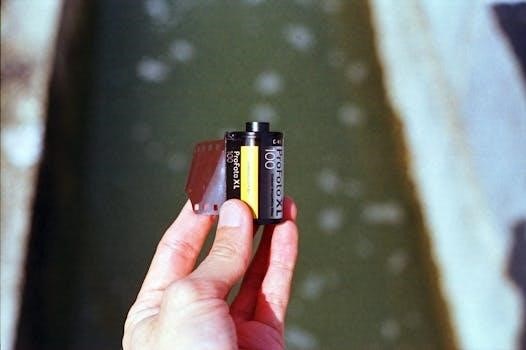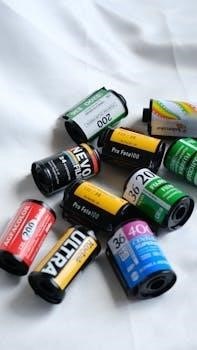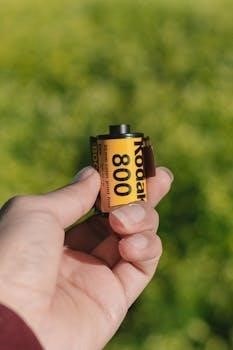Kodak M35 Manual⁚ A Comprehensive Guide
Welcome to the ultimate guide for the Kodak M35 film camera! This manual provides everything you need to know, from initial setup to capturing stunning photos. Whether you’re a beginner or experienced photographer, this guide is for you.
The Kodak M35 is a reusable 35mm film camera designed for simplicity and fun, harking back to the nostalgic era of film photography. Unlike disposable cameras, the M35 allows you to reload film, making it an environmentally conscious and cost-effective choice for capturing memories. Its fixed-focus lens ensures ease of use, making it perfect for beginners and seasoned photographers alike.
Inspired by the cameras of the nineties, the Kodak M35 offers a straightforward point-and-shoot experience. It’s lightweight and compact, making it easy to carry wherever you go. The camera requires 35mm film, readily available in various ISO speeds to suit different lighting conditions. With its manual film winding and rewinding mechanism, the M35 offers a tactile experience that digital cameras simply can’t replicate. This camera is an excellent option for anyone looking to explore the charm of film photography without the complexities of advanced equipment.
Complete with a hand strap, instruction manual, and packaged in a factory blister pack, the Kodak M35 is ready to use right out of the box. Enjoy the creative possibilities and capture beautiful moments with this classic film camera.
Key Features and Specifications of the Kodak M35
The Kodak M35 boasts several features that make it an appealing choice for film photography enthusiasts. It utilizes 35mm film, offering compatibility with a wide range of film stocks from ISO 200 to 400. Its fixed-focus lens ensures sharp images without the need for manual adjustments, simplifying the shooting process. The camera also includes a built-in flash, easily activated with a switch, ideal for low-light conditions or adding fill light to your subjects.
The M35 features manual film winding and rewinding, providing a hands-on experience reminiscent of classic film cameras. Its lightweight and compact design make it highly portable, perfect for travel and everyday use. The camera is powered by a single AAA battery, ensuring long-lasting performance. With its simple operation and reliable performance, the Kodak M35 is an excellent option for both beginners and experienced photographers looking to rediscover the joys of film photography.
Key specifications include a fixed aperture, a shutter speed optimized for general use, and a durable plastic construction. The Kodak M35 combines ease of use with the unique aesthetic of film, delivering a delightful photography experience.
Loading Film into the Kodak M35⁚ A Step-by-Step Guide
Loading film into your Kodak M35 is a straightforward process. First, gently pull up the film rewind knob located on the top left of the camera. This will open the camera’s back cover. Insert a fresh roll of 35mm film into the film chamber, ensuring the film canister is securely seated. Next, pull the film leader across the camera body and insert the end into the take-up spool’s slot. Make sure the film’s perforations align with the sprockets.
Gently turn the film advance wheel a few times to advance the film, ensuring it catches properly on the take-up spool. Close the camera back, and continue advancing the film until the frame counter displays “1.” This winds past the exposed portion of the film. Now, your camera is ready to capture those precious moments! Always load film in a shaded area to prevent accidental exposure. Double-check that the film is advancing correctly each time you wind to avoid wasted shots. With these simple steps, you’ll be ready to start shooting with your Kodak M35 in no time.
Using the Kodak M35⁚ Focusing and Shooting
The Kodak M35 is designed for simplicity, making focusing and shooting a breeze. Since it features a fixed-focus lens, you don’t need to worry about manual adjustments. Simply point your camera at your subject. Ensure your subject is within a reasonable distance – ideally not too close or too far. Compose your shot by looking through the viewfinder. Frame the image to your liking, considering the rule of thirds or other compositional techniques.
Once you’re satisfied with the composition, gently press the shutter button to capture the photo. The M35’s straightforward design minimizes complex settings, so you can focus on capturing the moment. Remember that lighting is key to achieving good results. In low-light situations, consider using the built-in flash, which is activated via a switch on the front of the camera. After taking a shot, advance the film using the film advance lever to prepare for the next photo. With these simple steps, you’ll be able to use the Kodak M35 to capture stunning photos.
Understanding the Flash Function on the Kodak M35

The Kodak M35 features a built-in flash, designed to enhance your photos in low-light conditions. Understanding how to effectively use this flash is crucial for capturing well-lit images. To activate the flash, locate the switch on the front of the camera, usually marked with a lightning bolt symbol. Slide the switch to the “on” position. A small indicator light may illuminate, signaling that the flash is charging. Allow a few seconds for the flash to fully charge before taking your photo.
When shooting indoors or in dimly lit environments, the flash provides additional illumination to properly expose your subject. Be mindful of the flash’s range, as it’s most effective within a few meters. Avoid using the flash in overly bright conditions, as it can wash out the image. After taking a photo with the flash, it will automatically recharge for the next shot. Remember to turn the flash off when shooting in well-lit environments to conserve battery power. With practice, you’ll learn to master the M35’s flash function.
Rewinding and Unloading Film from the Kodak M35
Once you’ve finished shooting your roll of film, it’s time to rewind and unload it from your Kodak M35. First, locate the rewind lever, usually found on the top of the camera. Gently flip out the rewind lever and begin turning it in the direction indicated by the arrows on the camera body. You’ll feel resistance at first, but as you rewind the film back into the canister, the resistance will decrease. Listen carefully for a distinct “pop” or release sound, which indicates that the film has fully detached from the take-up spool.

Once you hear the pop, you can open the camera’s back cover. To do this, locate the latch on the side of the camera and gently release it. Carefully remove the film canister from the camera. It’s important to handle the film with care to avoid accidentally exposing it to light. Take the exposed film to your local photo lab for developing. With practice, rewinding and unloading film from the Kodak M35 becomes a simple process.

Troubleshooting Common Issues with the Kodak M35
Like any camera, the Kodak M35 can sometimes encounter issues. One common problem is film jamming. If the film isn’t advancing properly, ensure it’s loaded correctly and the rewind lever is disengaged. Another issue is blurry images. The M35 has a fixed-focus lens, so it’s essential to maintain a reasonable distance from your subject and hold the camera steady. If your photos are consistently dark, check the lighting conditions and consider using the flash, especially indoors or in low light.
If the flash isn’t firing, make sure the batteries are fresh and correctly installed. Also, verify that the flash switch is turned on. If you’re still experiencing problems, try cleaning the battery contacts with a dry cloth. Finally, if the camera’s back cover won’t close securely, check for any obstructions or damage to the latch mechanism. Addressing these common issues can help keep your Kodak M35 in working order.
Tips for Taking Great Photos with the Kodak M35

The Kodak M35, while simple, can produce fantastic photos with a few key tips. Firstly, always consider your lighting. The M35 performs best in bright, natural light. When indoors or in low-light conditions, use the built-in flash to avoid underexposed images. Pay attention to composition; think about the rule of thirds and how you frame your subjects. Since the M35 has a fixed-focus lens, be mindful of your distance to the subject. Stay within the optimal focus range to ensure sharpness.
Experiment with different angles and perspectives to add creativity to your shots. Don’t be afraid to get close to your subject for more intimate portraits, or step back to capture a wider scene. Remember that film photography is about capturing moments, so be patient and enjoy the process. Embrace imperfections, as they often add character to film photos. Finally, consider using a variety of film stocks to achieve different looks and effects.
Choosing the Right Film for Your Kodak M35
Selecting the right film is crucial for achieving desired results with your Kodak M35. This camera works best with 35mm film, but the ISO sensitivity is a key factor. For bright, sunny days, an ISO 200 film is ideal, providing balanced exposure and vibrant colors; On overcast days or when shooting indoors with ample light, ISO 400 film will perform well, offering more flexibility in various lighting conditions.
For low-light situations or indoor photography with flash, consider using an ISO 800 film. This higher sensitivity will help capture more light and reduce the risk of underexposed images. Experiment with different film stocks to discover your preferred aesthetic. Color film offers a range of options, from vivid and saturated to more muted and natural tones. Black and white film provides a classic, timeless look, perfect for capturing dramatic scenes and portraits.
Caring for Your Kodak M35⁚ Maintenance and Storage
Proper care and storage are essential for extending the life of your Kodak M35. After each use, gently wipe the exterior with a soft, dry cloth to remove any dust, fingerprints, or debris. Avoid using harsh chemicals or abrasive cleaners, as these can damage the camera’s finish. Pay special attention to the lens, using a lens cleaning cloth to keep it free from smudges and scratches.
When not in use, store your Kodak M35 in a cool, dry place away from direct sunlight and extreme temperatures. A camera bag or case provides added protection against dust, moisture, and accidental bumps. If you won’t be using the camera for an extended period, remove the batteries to prevent corrosion. Before storing, ensure the camera is completely dry to avoid mold or mildew growth. Regular maintenance will keep your Kodak M35 in excellent condition, ready to capture memories for years to come.
Where to Find a Kodak M35 Manual (Free Options)
Need a manual for your Kodak M35? Luckily, several free options are available online. Start by checking the official Kodak website, which often provides downloadable manuals for their products. If you can’t find it there, try searching online forums and communities dedicated to film photography. These forums often have shared resources, including user manuals.
Another great option is to visit websites that specialize in hosting manuals for various devices. These sites typically allow you to search by brand and model, making it easy to find the specific manual you need. Always ensure the website is reputable before downloading any files. Additionally, consider contacting Kodak’s customer support, as they may be able to provide a digital copy of the manual or direct you to a reliable source. With a bit of searching, you can easily find a free Kodak M35 manual to guide you through its features and operation.